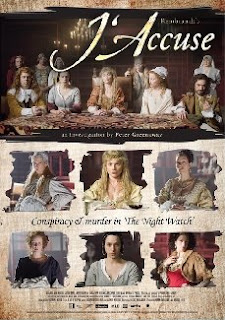 I haven’t seen Greenaway’s Nightwatching, his other film on Rembrandt’s famous, potentially infamous, painting The Night Watch; nor have I seen any Greenaway films until now (embarrassing, I know; still waiting for that Criterion The Cook, The Thief…). Rembrandt’s JAccuse is, from what I understand, another incarnation of Greenaway’s obsession over solving The Night Watch; Nightwatching is a fictionalization of the process and aftermath of painting the piece, and J’Accuse is a handheld walk through the ’30 mysteries’ of The Night Watch, narrated and theorized by Greenaway himself. To say that I didn’t learn anything from this film would be a lie, same for saying that most of it wasn’t surprisingly entertaining; but, I still question the point of it. Most of the information in this film could just as easily have been conveyed in a well-organized and elegantly designed brochure (and much quicker, too). The film is literally divided into 30 chapters, each numbered and dedicated to one of the apparently well-known 30 mysteries. Much of the ‘solving’ of the mysteries in the film is done by showing clips from Nightwatching, with a picture-in-picture frontal view of Greenaway speaking to the audience (why this ugly box, placed just below the center of the frame, couldn’t have been eliminated in favor of a simple voiceover, I do not know). Over-dramatic music is pervasive, and evoked the decade’s other bizarre, painting-solving film, The Da Vinci Code. The picture-in-picture narration, as well as all kinds of clip art swipes, wipes, hops, zooms and scrolling texts gave the film a Powerpoint aesthetic that cheapened an otherwise well-produced assemblage. There are questionable things in the ‘clues’ that Greenaway relies on in the film (most obviously his claims that the man in the center of the painting is holding a right-handed glove, when it is clearly left-handed), but much of it is thought-provoking, if a bit Art History 101. The cumulative effect is likely to make someone more curious about the subtext and symbolism in 16th and 17th century paintings, which is commendable.
I haven’t seen Greenaway’s Nightwatching, his other film on Rembrandt’s famous, potentially infamous, painting The Night Watch; nor have I seen any Greenaway films until now (embarrassing, I know; still waiting for that Criterion The Cook, The Thief…). Rembrandt’s JAccuse is, from what I understand, another incarnation of Greenaway’s obsession over solving The Night Watch; Nightwatching is a fictionalization of the process and aftermath of painting the piece, and J’Accuse is a handheld walk through the ’30 mysteries’ of The Night Watch, narrated and theorized by Greenaway himself. To say that I didn’t learn anything from this film would be a lie, same for saying that most of it wasn’t surprisingly entertaining; but, I still question the point of it. Most of the information in this film could just as easily have been conveyed in a well-organized and elegantly designed brochure (and much quicker, too). The film is literally divided into 30 chapters, each numbered and dedicated to one of the apparently well-known 30 mysteries. Much of the ‘solving’ of the mysteries in the film is done by showing clips from Nightwatching, with a picture-in-picture frontal view of Greenaway speaking to the audience (why this ugly box, placed just below the center of the frame, couldn’t have been eliminated in favor of a simple voiceover, I do not know). Over-dramatic music is pervasive, and evoked the decade’s other bizarre, painting-solving film, The Da Vinci Code. The picture-in-picture narration, as well as all kinds of clip art swipes, wipes, hops, zooms and scrolling texts gave the film a Powerpoint aesthetic that cheapened an otherwise well-produced assemblage. There are questionable things in the ‘clues’ that Greenaway relies on in the film (most obviously his claims that the man in the center of the painting is holding a right-handed glove, when it is clearly left-handed), but much of it is thought-provoking, if a bit Art History 101. The cumulative effect is likely to make someone more curious about the subtext and symbolism in 16th and 17th century paintings, which is commendable.
